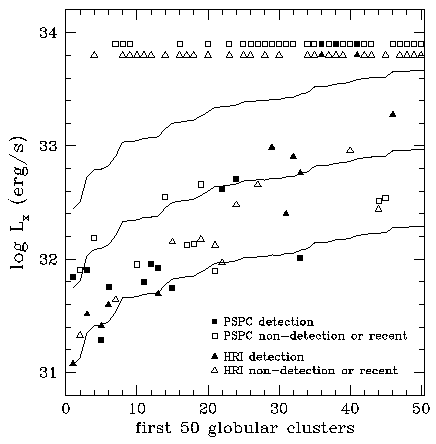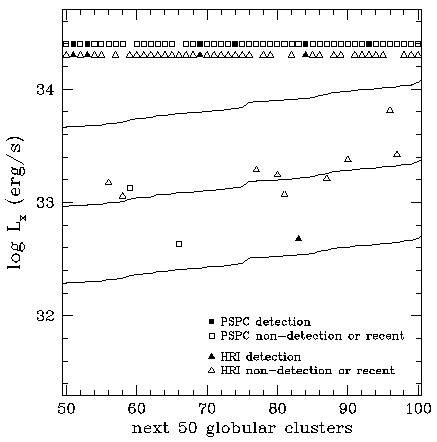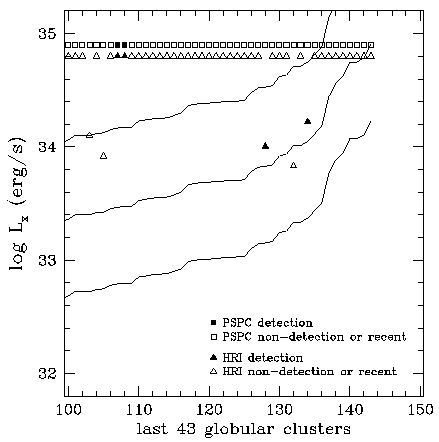ROSAT HRI SURVEYS OF GLOBULAR CLUSTERS
A. M. Cool
University of California, Berkeley, cool ![]() astro.berkeley.edu
astro.berkeley.edu
Abstract:
ROSAT HRI's unique combination of high spatial resolution and sensitivity is providing critical new insight into the results of stellar interactions in globular cluster cores. It has already more than tripled the number of X-ray sources known in clusters, while simultaneously providing the positional accuracy needed to identify their optical counterparts. Yet the fraction of Galactic globular clusters observed to date is small, particularly observations sensitive enough to readily detect the largest class of sources. Further understanding of the nature and origin of these compact binary stars and their role in cluster dynamics will profit from systematic surveys of large, unbiased samples of clusters. Examples of possible survey strategies are described.
X-ray Binaries in Globulars
The discovery of bright X-ray point sources provided some of the earliest evidence of the existence of binary stars in globulars, which have been notoriously difficult to find and study. The subsequent discovery of a larger population of much fainter X-ray sources suggested that compact accreting binaries could be quite abundant in globulars (Hertz and Grindlay 1983). These systems are likely to be the products of 2- and 3-body stellar interactions, many of which may involve exchange interactions with primordial binaries. The formation and subsequent behavior of binaries in cluster cores is widely believed to play a crucial role in the dynamical evolution of globulars, but few of the details of this process are yet understood.
Deep X-ray imaging of globulars provides a unique glimpse into stellar interactions in clusters by revealing the populations of low-luminosity sources they contain. These sources are likely to be an admixture of white dwarf and neutron star accretors (cataclysmic variables and quiescent low-mass X-ray binaries), with the neutron star systems occupying the bright end of the dim-source luminosity function. Determining the conditions that give rise to the formation of these binaries is an important goal that has yet to be fully realized.
ROSAT Results
Pointed observations of 43 Galactic globular clusters have been made or are in progress with ROSAT, 35 with the HRI (see Figures 1-3). These studies have shown that
1. Low-luminosity X-ray sources are indeed far more numerous in clusters than their high-luminosity counterparts. Thirty low-luminosity sources are now known in 18 clusters (Verbunt 1996), which more than triples the number identified with Einstein.
2. In nearly every globular in which one or more low-luminosity
sources have been detected, sources have been detected at or near the
detection limit of the observation, indicative of a rising luminosity
function. Estimates of a power-law slope of the luminosity function
from current data are in the range ![]() = 0.5-1.0 (Grindlay 1995,
Johnston and Verbunt 1996).
= 0.5-1.0 (Grindlay 1995,
Johnston and Verbunt 1996).
3. Four of the eight clusters for which the deepest exposures have been made contain three or more faint sources (Cool et al. 1993, Grindlay 1993, Hasinger et al. 1994). In every case, the spatial resolution of the HRI has been essential to separate the sources from one another in order to properly assess their numbers, luminosities, and spatial distribution in the cluster.
4. Low-luminosity sources are present in clusters with a wide range
of properties. The only cluster for which an observation sensitive to
sources as faint as L ![]() erg s
erg s ![]() detected no
sources in the cluster is M71, which has both a low central density
and a low mass.
detected no
sources in the cluster is M71, which has both a low central density
and a low mass.
5. Some of the dim sources have highly variable X-ray luminosities (e.g., Hasinger et al. 1994), so that observations at different epochs detect a different (though generally overlapping) subset of the cluster sources. An accurate assessment of the number of sources in a cluster can thus require repeated observation.
At the same time, by providing X-ray source positions accurate to a few arc seconds, the ROSAT HRI has made it feasible to identify optical counterparts even in crowded cluster cores. Promising identifications have now been made for sources near the cores of three different clusters (Cool et al. 1995; Edmonds et al. 1996; Bailyn et al. 1996), and follow-up spectroscopy of three stars in one cluster has revealed the emission lines characteristic of accretion disks (Grindlay et al. 1995). Studies by several groups are now underway to further characterize these once elusive binary stars through their optical properties.
 Figure 1: Limiting X-ray luminosities reached in ROSAT observations
of globular clusters, with clusters sorted according to the ease with
which faint sources can be detected. This plot represents the first
50 clusters in this sorted list. A 5 keV brems spectrum has been
assumed, and combined with cluster distances and reddenings to predict
expected limits in all existing and planned observations. Filled
symbols correspond to observations in which detections have been
reported. Points corresponding to unobserved clusters appear in a row
at the top. Solid curves represent limits that could be reached in 1,
10, and 100 ks of HRI exposure, top to bottom. Note the large
number of clusters which are either unobserved with ROSAT or for which
only shallow exposures have been taken.
Figure 1: Limiting X-ray luminosities reached in ROSAT observations
of globular clusters, with clusters sorted according to the ease with
which faint sources can be detected. This plot represents the first
50 clusters in this sorted list. A 5 keV brems spectrum has been
assumed, and combined with cluster distances and reddenings to predict
expected limits in all existing and planned observations. Filled
symbols correspond to observations in which detections have been
reported. Points corresponding to unobserved clusters appear in a row
at the top. Solid curves represent limits that could be reached in 1,
10, and 100 ks of HRI exposure, top to bottom. Note the large
number of clusters which are either unobserved with ROSAT or for which
only shallow exposures have been taken.
Surveys with the HRI
A primary goal of studies of X-ray sources in globulars is to determine the conditions necessary for their formation, and to understand their evolutionary relationship to populations of other cluster stars such as millisecond pulsars, primordial binary stars, and various possible merger products in cluster cores. Intercomparisons of the relative numbers of low-luminosity X-ray sources vs. millisecond pulsars, blue stragglers and extreme blue horizontal branch stars will provide valuable constraints on ongoing efforts to understand the consequences of stellar interactions in cluster cores. On the optical side, HST is providing greatly improved information about the distribution of unusual blue stars in a large number of clusters. Only ROSAT HRI can provide the complementary database of low-luminosity X-ray sources in clusters. By assessing the numbers, luminosities, variability characteristics, and radial distribution of dim sources in clusters with a wide variety of properties, a more complete picture of cluster evolution can be developed.
 Figure 2: Same as Figure 1, for next 50 clusters in sorted list. Unobserved
clusters appear in a row at the top.
Figure 2: Same as Figure 1, for next 50 clusters in sorted list. Unobserved
clusters appear in a row at the top.
Statistical analyses at present are constrained both by the small
number of clusters studied and the limited number of sources that have
been identified. This is particularly true for the faintest sources,
for which sufficiently sensitive
HRI observations have been obtained for only 8 clusters.
Another dozen clusters have been examined to a depth of
L erg s ![]() , but even these represent less than 1/7 of
Galactic globular clusters. Moreover, the existing sample of clusters
that has been observed has been biased toward the clusters believed
most likely to contain sources. Finally, as few clusters have been
observed repeatedly, relatively little is known about the variability
characteristics of these sources, and of the way this may affect the
overall assessment of their numbers.
, but even these represent less than 1/7 of
Galactic globular clusters. Moreover, the existing sample of clusters
that has been observed has been biased toward the clusters believed
most likely to contain sources. Finally, as few clusters have been
observed repeatedly, relatively little is known about the variability
characteristics of these sources, and of the way this may affect the
overall assessment of their numbers.
 Figure 3: Same as Figure 1, for last 43 clusters in sorted list. Unobserved clusters appear in a row at the top.
Figure 3: Same as Figure 1, for last 43 clusters in sorted list. Unobserved clusters appear in a row at the top.
From Figures 1-3 it can be seen that it is not feasible to reach the faintest sources in every cluster in any reasonable amount of time. Instead, one can envisage a variety of smaller surveys aimed at specific issues. Here we describe three such possible surveys that would help to fill the gaps in the existing ROSAT database on globular clusters.
1. A deep survey reaching L ![]() erg s
erg s ![]() in all
clusters in which this can be accomplished in 100 ks or less. There
are 24 such clusters (see Figure 1). For clusters in this category that
have already been observed, only the additional exposure time needed
to reach the desired limiting luminosity would be required. This
survey could be carried out in a total exposure time of order 1 Ms,
and would more than double the sample of clusters for which X-ray
luminosities typical of cataclysmic variables are reached.
in all
clusters in which this can be accomplished in 100 ks or less. There
are 24 such clusters (see Figure 1). For clusters in this category that
have already been observed, only the additional exposure time needed
to reach the desired limiting luminosity would be required. This
survey could be carried out in a total exposure time of order 1 Ms,
and would more than double the sample of clusters for which X-ray
luminosities typical of cataclysmic variables are reached.
2. A shallower survey reaching L erg s ![]() in all
clusters in which this could be accomplished in 20 ks or less. This
survey would be aimed at the brightest of the low-luminosity sources,
which may be neutron star accretors (Verbunt et al. 1984), and may
thus constitute a separate class from the fainter of the
low-luminosity sources. Thirty of the 80 clusters in this sample have
already been observed and would not need to be reobserved. Such a
survey could be completed in of order 1 Ms.
in all
clusters in which this could be accomplished in 20 ks or less. This
survey would be aimed at the brightest of the low-luminosity sources,
which may be neutron star accretors (Verbunt et al. 1984), and may
thus constitute a separate class from the fainter of the
low-luminosity sources. Thirty of the 80 clusters in this sample have
already been observed and would not need to be reobserved. Such a
survey could be completed in of order 1 Ms.
3. A survey aimed at assessing the variability characteristics of the low-luminosity sources. A sample of clusters could be selected to maximize the number of sources that would be remeasured (e.g., by examining clusters known to contain multiple sources) while minimizing the total required exposure time. The sample should include clusters in which the faintest low-luminosity sources are know to exist, as well as clusters in which brighter low-luminosity sources have been identified. Hints that the latter are more highly variable than the former could have interesting implications (Bailyn 1995, 1996), but at present the statistics are rather poor.
Conclusion
The unique capabilities of the ROSAT HRI are needed to provide vital information about accreting binary stars in globular clusters. Results obtained to date demonstrate that certain classes of these binary systems are quite abundant in clusters, and can provide important insight into the complex dynamics of globular clusters. Systematic surveys aimed at measuring their populations and characteristics in a large number of clusters would provide the database needed for detailed statistical analyses. The time for such surveys is particularly auspicious given the capabilities of HST to identify optical counterparts and systematically study other related binary systems. Such surveys would also be of significant use in planning future AXAF observations of globular clusters, both in terms of honing of scientific questions and in selecting targets most in need of the exceptional resolution of AXAF.
References
Bailyn, C. D. 1995, Ann. Rev. Astron. Ap. 33, 133
Bailyn, C. D. 1996, in ASP Conf. Series #90, eds. E. F. Milone & J.-C. Mermilliod, p. 320
Bailyn et al. 1996, submitted to ApJ
Cool, A. M., et al. 1995, ApJ, 439, 695
Edmonds, P. D. et al. 1996, preprint
Grindlay, J. E. 1995, in ASP Conf. Series #72, eds. A. S. Fruchter, M. Tavani & D. C. Backer, p. 57
Grindlay, J. E. 1993, in ASP Conf. Series #50, eds. G. Djorgovski and G. Meylan, p. 285
Grindlay, J. E. et al. 1995, ApJ, 455, L47
Johnston, H. M. and Verbunt, F. 1996, A&A, preprint
Hasinger, G. et al. 1994, A&A, 136, 331
Hertz, P. and Grindlay, J. E. 1983, ApJ, 275, 105
Verbunt, F. 1996, in ASP Conf. Series #90, eds. E. F. Milone & J.-C. Mermilliod, p. 163
Verbunt, F., van Paradijs, J., and Elson, R. 1984, MNRAS, 210, 899
Return to the Title Page
About this document ...
This document was generated using the LaTeX2HTML translator Version 96.1 (Feb 5, 1996) Copyright © 1993, 1994, 1995, 1996, Nikos Drakos, Computer Based Learning Unit, University of Leeds.
The command line arguments were:
latex2html -split 0 cool.tex.
The translation was initiated by Michael Arida on Mon Jun 3 11:48:21 EDT 1996
Michael Arida
Mon Jun 3 11:48:21 EDT 1996

